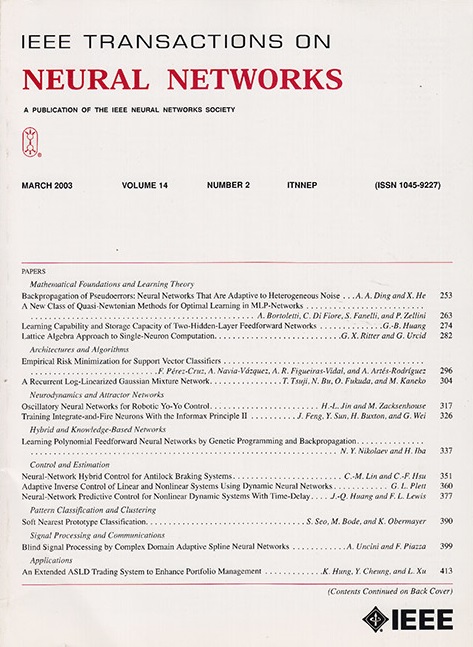基于灵活混合的多级信息互补融合网络用于 HSI-X 图像分类
IF 10.2
1区 计算机科学
Q1 COMPUTER SCIENCE, ARTIFICIAL INTELLIGENCE
IEEE transactions on neural networks and learning systems
Pub Date : 2023-08-14
DOI:10.1109/TNNLS.2023.3300903
引用次数: 0
摘要
基于 Mixup 的数据增强方法已被证明有利于模型在训练过程中的正则化,尤其是在训练数据稀缺的遥感领域。然而,在数据扩增过程中,基于 Mixup 的方法会忽略不同输入中的目标比例,并保持线性插入比例的一致性,这就导致了由于扩增过程的随机性,即使在混合图像中没有引入有效对象,也会对标签空间产生响应。此外,尽管之前的一些研究尝试利用不同的多模态交互策略,但这些策略并不能很好地扩展到各种遥感数据组合中。为此,我们提出了一种基于灵活混合的多阶段信息互补融合网络(Flex-MCFNet),用于高光谱-X 图像分类。首先,为了弥补混合图像与标签之间的差距,设计了一种灵活混合(FlexMix)数据增强策略,即标签的权重随输入图像的比例增加而增加,以防止因引入无效信息而对标签空间造成负面影响。更重要的是,为了总结包括各种模态补充和不确定性在内的多种遥感数据输入,开发了多级信息互补融合网络(MCFNet)。在分别提取高光谱和互补模态 X-模态(包括多光谱、合成孔径雷达(SAR)和光探测与测距(LiDAR))的特征后,通过多级信息互补和融合,互补模态之间的信息得到充分交互和增强,并用于最终的图像分类。广泛的实验结果表明,Flex-MCFNet 不仅能有效地扩展训练数据,还能对不同的数据组合进行充分的正则化处理,从而达到最先进的性能。本文章由计算机程序翻译,如有差异,请以英文原文为准。
A Multistage Information Complementary Fusion Network Based on Flexible-Mixup for HSI-X Image Classification
Mixup-based data augmentation has been proven to be beneficial to the regularization of models during training, especially in the remote-sensing field where the training data is scarce. However, in the process of data augmentation, the Mixup-based methods ignore the target proportion in different inputs and keep the linear insertion ratio consistent, which leads to the response of label space even if no effective objects are introduced in the mixed image due to the randomness of the augmentation process. Moreover, although some previous works have attempted to utilize different multimodal interaction strategies, they could not be well extended to various remote-sensing data combinations. To this end, a multistage information complementary fusion network based on flexible-mixup (Flex-MCFNet) is proposed for hyperspectral-X image classification. First, to bridge the gap between the mixed image and the label, a flexible-mixup (FlexMix) data augmentation strategy is designed, where the weight of the label increases with the ratio of the input image to prevent the negative impact on the label space because of the introduction of invalid information. More importantly, to summarize diverse remote-sensing data inputs including various modal supplements and uncertainties, a multistage information complementary fusion network (MCFNet) is developed. After extracting the features of hyperspectral and complementary modalities [X-modal, including multispectral, synthetic aperture radar (SAR), and light detection and ranging (LiDAR)] separately, the information between complementary modalities is fully interacted and enhanced through multiple stages of information complement and fusion, which is used for the final image classification. Extensive experimental results have demonstrated that Flex-MCFNet can not only effectively expand the training data, but also adequately regularize different data combinations to achieve state-of-the-art performance.
求助全文
通过发布文献求助,成功后即可免费获取论文全文。
去求助
来源期刊

IEEE transactions on neural networks and learning systems
COMPUTER SCIENCE, ARTIFICIAL INTELLIGENCE-COMPUTER SCIENCE, HARDWARE & ARCHITECTURE
CiteScore
23.80
自引率
9.60%
发文量
2102
审稿时长
3-8 weeks
期刊介绍:
The focus of IEEE Transactions on Neural Networks and Learning Systems is to present scholarly articles discussing the theory, design, and applications of neural networks as well as other learning systems. The journal primarily highlights technical and scientific research in this domain.
 求助内容:
求助内容: 应助结果提醒方式:
应助结果提醒方式:


